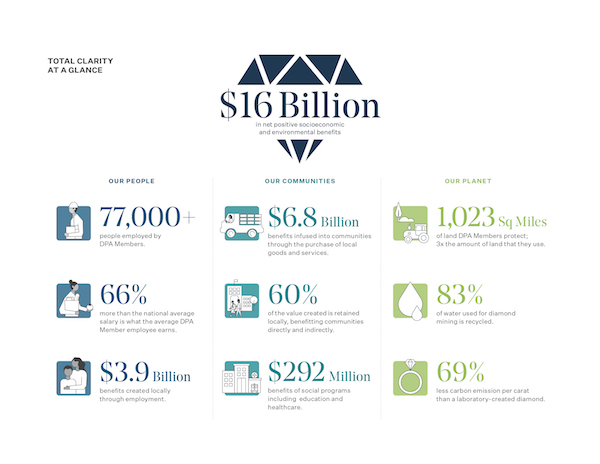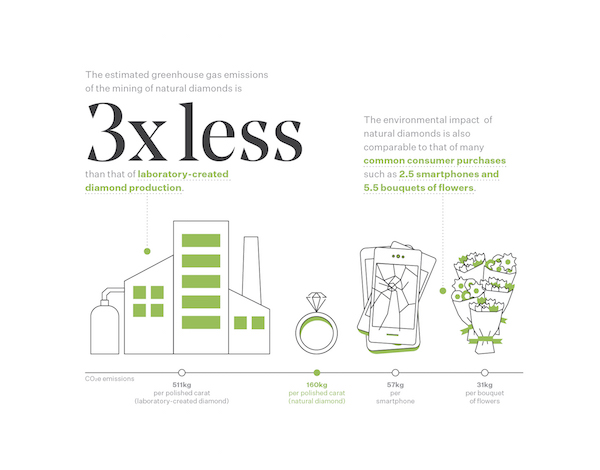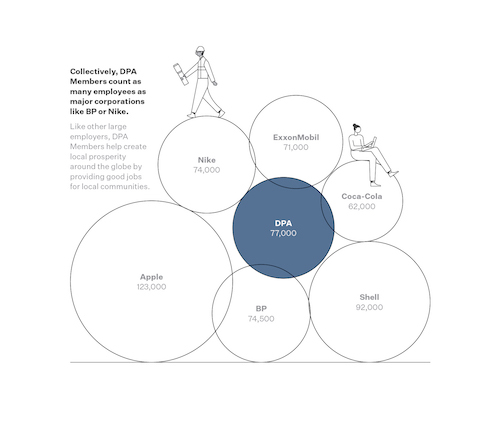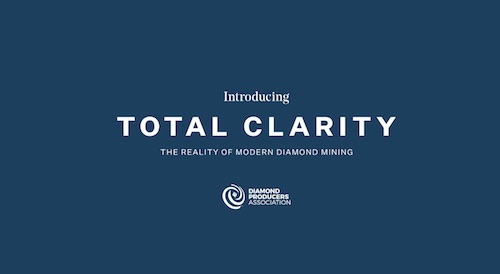Articles and News
Independent Report Finds Lab-Grown Diamonds May Use More Energy, Not Less, Than Mined | May 08, 2019 (1 comment)

New York, NY—Seizing upon consumer concerns about conflict diamonds and the environment, lab grown diamond companies quickly grabbed the narrative about both as a focal point for their marketing. But just-released data from a two-year research study pokes a lot of holes in growers’ claims that their product is environmentally superior to natural mined diamonds. This comes on the heels of last month’s U.S. Federal Trade Commission’s warning to growers not to overstate their environmental benefits in advertising.
Related: FTC Slaps Lab-Grown Companies With Ad Warnings
The report, titled The Socioeconomic and Environmental Impact of Large-Scale Diamond Mining, is the world’s first comprehensive socioeconomic and environmental analysis of the diamond-mining sector at all. Although commissioned by the Diamond Producers Association (DPA), the report was independently conducted by Trucost ESG Analysis, part of S&P Global. It covers impact on local communities, employees, and the environment, from the seven diamond mining companies that comprise the DPA and account for 75% of the world’s diamond production. When possible it compares those to lab-grown companies’ claims of better environmental impact.
DPA also has announced the launch of the Total Clarity platform, a new website that puts socioeconomic data from diamond mining into a transparent, easy-to-understand format using hard data and illustrated case studies. Its first report can be accessed on www.Total-Clarity.com or via Instagram, @TotalClarityDiamonds.
“Total Clarity is an important milestone for the industry and is the start of what needs to be an ambitious industry effort towards communicating the reality of our industry today. We are reaching out to the entire industry with tools that will help everyone relay and amplify this information through their own channels and members,” says Sarah Gorvitz, DPA senior vice president of communications and insights.
As part of that launch, DPA has created a Total Clarity retailer toolkit (available on DPA’s trade portal at diamondproducers.com) that includes fact sheets and social media assets, with a printed brochure coming soon. The tools include information about carbon emissions about lab-grown diamonds and natural diamonds. DPA’s website also features a content series called the “Essential Diamond Truths” and #DiamondFacts which offer fact-based information about lab-grown diamonds.
Relevant information from the study also will be incorporated into DPA’s E-learning platform and the in-store presentations it is making about its female self-purchase campaign, “For Me From Me.”
In Las Vegas, DPA will cover these issues in a JCK Talks session, linked here, on Friday, May 31, from 4:00 - 5:30 pm in Room 303, Level 1, in the Sands. “We invite all Centurion readers to attend,” Gorvitz told The Centurion.
Watch a video of DPA CEO Jean-Marc Lieberherr discussing the study and the Total Clarity platform here or by clicking on the image below.
Natural diamond benefits. DPA members generate more than US $16 billion in net socioeconomic and environmental benefits through their diamond mining operations, the majority of which are infused into communities through local employment, sourcing of goods and services, taxes and royalties, social programs, and infrastructure investment, says the report. Additionally, DPA members pay their employees and contractors, on average, 66% above national average salaries in the countries where they work, and they provide superior training to create a skilled workforce.

But the report also highlights areas for improvement and creates a baseline to measure progress toward carbon dioxide emission reduction and land and water use goals.
CO2 emissions constitute the majority of diamond mining’s environmental impact, says the report. It found that collectively, the seven DPA mining companies emitted the equivalent of 160 kg of carbon dioxide (CO2) per polished carat produced. By comparison, a 15-inch, 265GB Apple MacBook Pro creates 264 kg, a lab-grown diamond creates 511 kg per polished carat (TruCost estimate), and the monthly energy use of an average U.S. household creates 696 kg.
Each DPA member has set goals to reduce these emissions.

In terms of more tangible environmental impact, the report found DPA members produced an average of 4,350 Kg of waste rock residues per polished carat, and 1.86 Kg of industrial waste per polished carat, of which 26% (0.5 Kg per polished carat) was recycled.
Water depletion per carat of natural diamonds averaged 7.3 cubic meters. In total, air, land, and water pollution emissions due to energy use and other processes at mine sites represent 6% of total impacts. Like their CO2 emission figures, DPA members will use this data as a baseline to track progress going forward.
Compared to what? The challenge with making direct comparisons to lab-grown diamonds’ environmental impact is that there’s very little direct data available from that sector, and none of it is third party verified, says DPA CEO Jean-Marc Lieberherr. Trucost had extrapolate information from what sources are available, including scientific literature and press reports, to arrive at its estimates for the lab-grown sector’s environmental impact, which includes both energy and water consumption.
For instance, a lab-grown diamond reactor requires heat—at a temperature similar to the heat of the sun—and cooling it down requires millions of gallons of water each year, Lieberherr explains.
Lieberherr acknowledged that while the Trucost report currently presents a picture favorable toward diamond mining, he would welcome transparency from the lab-grown sector, even if it means those numbers change in the future.
“This report marks an industry first. Diamond producing companies representing three quarters of the world’s production have come together to provide a window into the impacts and benefits of their activities on the communities and environments of the countries and regions in which they operate,” he said.
"This report marks the first time Trucost has seen an industry come together to measure its environmental, social and economic benefits and impacts," echoed Libby Bernick, managing director and global head of Trucost Corporate Business.

Key report findings include:
- DPA member companies offer high-paying jobs, excellent job training, and a safe work environment to people from local communities, creating opportunities that often become long-term careers.
- DPA members employ 77,000 people worldwide, comparable to Fortune 500 companies such as Coca-Cola, Hewlett Packard, and Nike.
- The average DPA member employee or contractor is paid 66% more than the national average salary and receives nearly five times the living wage in his or her country.
- Safety incidents at DPA member companies are a small fraction of those observed in similar sectors.
- Members purchase the bulk of the goods and services needed for their operations from local businesses, creating a significant, lasting impact on local economies.
- They pay a large share of their revenues to diamond mining countries in the form of taxes, royalties and dividends. Botswana is an example of an entire nation being transformed by diamond revenues over the past 50 years.
- DPA members infused US $6.8 billion in benefits into local communities through the purchase of local goods and services.
- Local communities receive US $3.9 billion in positive benefits through employment and social programs such as health and education.
- DPA members’ tax revenue, royalties and dividends ($3 billion) fund local infrastructure and other civic improvements.
- Controlling and continuing to reduce its environmental footprint is a clear priority for diamond mining companies, through increased access to renewable energies, energy reduction initiatives, and carbon capture research programs.
- DPA members collectively protected more than 260,000 hectares (1,000 square miles) of natural land in Russia, Botswana, South Africa, Tanzania, Australia, and Canada.
- Globally, members protect three times the land they use for mining and implement long-term biodiversity conservation programs.
- Each DPA member produces sustainability and improvement progress reports, available on DPA’s website.

The full report and more information on Trucost’s methodology is available here.
DPA members include: ALROSA, De Beers Group, Dominion Diamond Mines, Lucara Diamond Corp., Murowa Diamonds, Petra Diamonds and Rio Tinto. DPA members operate diamond mines in the following countries: Botswana, Russia, Canada, Namibia, South Africa, Lesotho, Australia, Zimbabwe and Tanzania.








